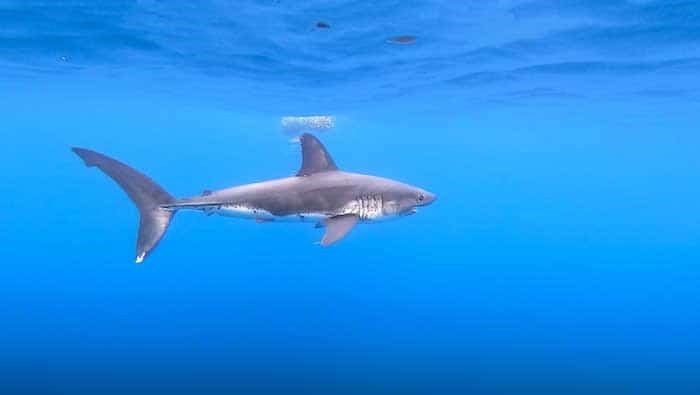 Photo: Du Preez / Department of Fisheries and Oceans Canada
Photo: Du Preez / Department of Fisheries and Oceans Canada
While they aren't an uncommon sight in B.C. waters, marine scientists were amazed by the way a particular shark behaved during a recent expedition.
A two-meters long Salmon Shark was spotted by a science team from Fisheries and Oceans Canada, the Nuu-chah-nulth Nations, and other partner organizations while they were on a two-week expedition. The male shark was captured on video, "heaving itself onto, and sliding along, a barnacle-encrusted log adrift at sea."
Researchers described the behaviour as extremely rare, and believe the shark was attempting to remove the large, visible parasites from its body and fins. These parasites are known as copepods, and are detrimental to the shark’s health and swimming efficiency.
The Pacific Seamounts Expedition team believes this is the first-ever recording of this type of behaviour in Salmon Sharks. The event was observed by Josh Watts (Nuu-chah-nulth Nations) and Cherisse Du Preez (Fisheries and Oceans Canada), as well as the Canadian Coast Guard crew.
Salmon Sharks have a short and heavy body, with a length up to three metres, and are black or dark grey on the top with white blotches on the bottom. They also have a short snout with awl-shaped teeth that have small, sharp denticles on each shoulder of the main point. An apex predator, they are known to feast on salmon, squid, sablefish, and herring.
According to the , Salmon Sharks are closely related to Great White Sharks and can swim up to 50 miles per hour. They can also, "regulate their body temperature 14 to 20 degrees Fahrenheit above the ambient water temperature."
The Pacific Seamounts Expedition set out on July 16 to explore Canada’s largest underwater volcano - the Explorer seamount - at the center of a potential . This mission will expand the knowledge of the 2018 Expedition where many species unknown to science were discovered that were once unknown to science.
Last year, a shark was spotted in the shallow water at the foot of Bayswater Street, a few blocks West of Kits Beach. Lee Newman, Â鶹´«Ã½Ó³»Aquarium’s curator of fishes, told V.I.A. that while it’s hard to tell from the photo, the shark is likely a Pacific Spiny Dogfish.
If you encounter a Salmon Shark, you are encouraged to to the Department of Fisheries and Oceans.


